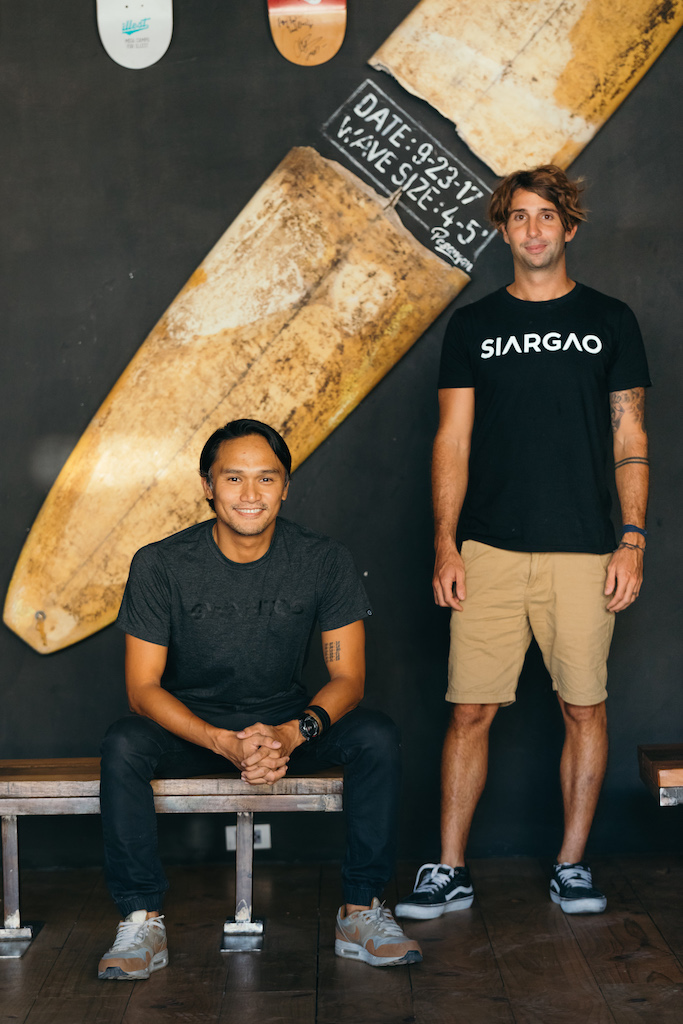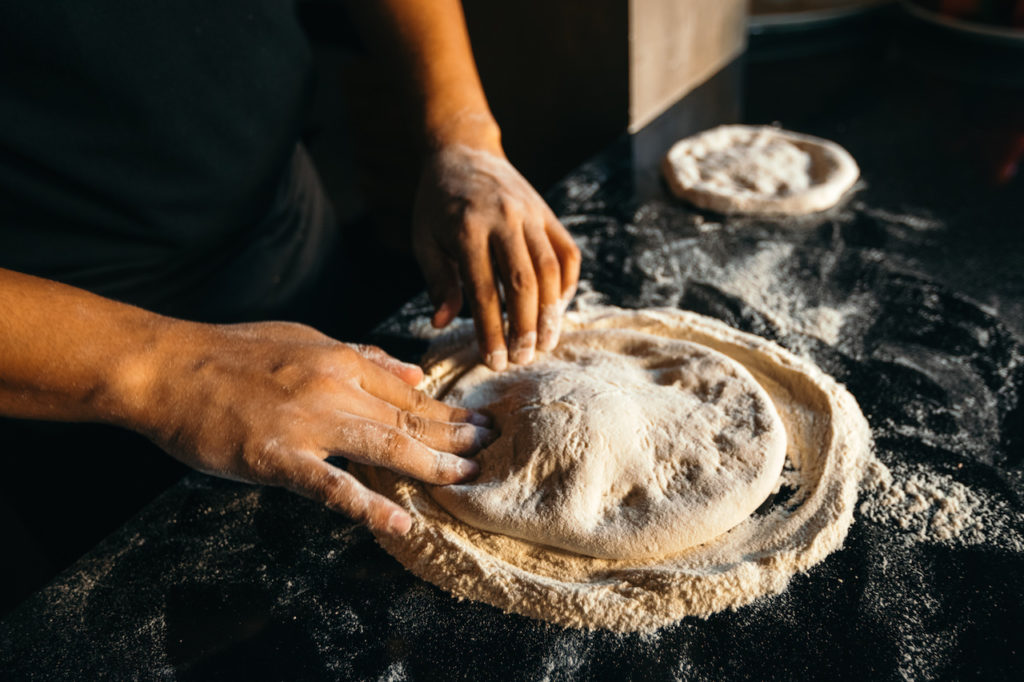When Kermit Surf Resort and Restaurant opened in Siargao in 2011, owner Gianni Grifoni seated all but five guests at a single table in his humble pizzeria by the beach. Fast forward to 2018, the restaurant debuts in Manila, gathering a cool crowd of about 300 and Grifoni—this time with Kermit Manila co-owner Eric Matic—is at wits’ end figuring out how they’ll survive opening night.
Birthing pains
“We wanted to cry because we felt like it was such a mess. There were so many people, so many orders. At one point, we were like, ‘What do we do? We close the kitchen? But we can’t!’ So I was thinking, ‘Okay, I’ll run away now and go back to Siargao to hide,’” says Grifoni with a hearty laugh, recalling how he and Matic were panicking the entire day on April 20. “But everybody was just so comforting and telling us, ‘It’s okay, guys. You have to learn from this.’ And then the next day, Saturday, it was busy and things went well.”
Grifoni, an Italian-Swiss marine-biologist-and-surfer-turned-resort-and-restaurant-owner, first visited Siargao in 2005 as a tourist eager to ride some waves. He fell in love with the area while working on a marine wildlife conservation project with the government and some NGOs in 2009, and eventually decided to acquire land on a tight budget in 2010.
The following year, he was running a small kitchen mainly dedicated to Italian cuisine, a move that came naturally to the expat since he grew up working part-time at his family’s restaurants in Italy and Switzerland. The restaurants were sold in 2009, and putting up Kermit was a way to continue what the Grifonis started “but in a different place.”


In 2016, Kermit became so ingrained in the Siargao scene that even Condé Nast Traveler deemed it a place that “serves up what might be the best pizza and fresh-made pastas in the country.” With everything done from scratch, ingredients guaranteed fresh, and pizzas made the traditional Napoli way, locals and tourists couldn’t help but agree the praise was well deserved.
“Now I have more than 118 employees in Siargao,” he says, adding that he now manages Kermit Siargao with his wife Rozie whom he met in 2013. “Nothing was planned. It was like a patchwork of my personal interests,” Grifoni says.
Even the name Kermit was also a result of having no foresight whatsoever. The place was named after a monk seal he was tracking while studying the species’ migration patterns in Hawaii years ago. It was meant to be temporary. Later on, he realized that changing the name would be too complicated, so the name stuck.
A satellite branch
But after laying the groundwork for the brand to flourish and gain a solid following, Grifoni always knew expansion was inevitable. Naturally, La Union was the surf junkie’s first choice when talk of a second restaurant surfaced last year, but Matic, who with his wife Tin Magsaysay-Matic of Locavore has been a regular of Kermit Siargao since 2012, proposed they bring Kermit to Manila instead.
“We didn’t want to compete with the crowd on the other side,” Matic says, explaining that they wanted to open a branch particularly in Poblacion because it had the same laid-back vibe of Siargao. Fortunately, they found a space that was on the quieter side of the area.
“I was really scared about Manila, but I know Eric and he’s the only person I would do something in Manila with. I know Locavore and I see that they do things really well. I know his wife. I’m a bit scared of her,” Grifoni says in jest.
Having Matic, an architect, on board also meant interiors that allowed customers to experience a piece of the surfing province in the city. “I wanted to retain as much of the Siargao look as possible, which is a lot of black chalkboard finish walls with chalk art on it. And I think the biggest challenge was how to bring that beach vibe to a place like Poblacion,” Matic says.
Most noticeable is how natural light floods the room, thanks to glass panels and Capiz window-inspired latticework seen on one of Kermit Manila’s walls. No Philippine beach experience is complete, after all, without the golden tinge of daylight. Also displayed on its walls and very much in line with Kermit’s surfer aesthetic are broken surfboards, all transferred from Siargao and each with its own story to tell.
If you look closely, every board indicates the date it was wrecked, the wave size that hit it, and the surf spot that wiped it out. These genuine stories are what make the core of Kermit, and this could also explain why the brand has been so well-loved all these years. At the end of the day, Kermit remains faithful to its foundation: authentic Italian grub and the surfer’s way of life.
“Gianni already established a name. When people think of Siargao, the next thing that pops into their mind is Kermit. He did a really good job in establishing that. That’s why we already had an advantage opening here,” says Eric Matic.
For Grifoni and Matic, bringing Kermit to Manila wasn’t really a question of whether or not Manila was ready for Kermit. The way they saw it, Manila embraces any new food place with a fan base. The question was whether Kermit was ready to take on Manila’s unyielding pace considering it has always been rooted in the easygoing lifestyle of Siargao.
“Gianni already established a name. When people think of Siargao, the next thing that pops into their mind is Kermit. He did a really good job in establishing that. That’s why we already had an advantage opening here,” Matic says.
Before Kermit Manila, people asked non-stop on social media when they’d be seeing Kermit in the metro. And now that they’ve finally opened in the urban city, Kermit loyalists have started to inquire as to when they can expect branches in Cebu and Davao. Although the support and feedback are nothing short of encouraging, Gianni still believes in taking it slow.
Perhaps this steady, step-by-step approach to growth is what allowed Kermit to ripen for Manila’s kinetic crowd in the first place, much like other provincial restaurants that also took years before they could set foot in the country’s capital. In the case of Kermit, though, there may be slight differences between the two restaurants.
“In Manila, we can actually source better ingredients than in Siargao. Some dishes might be better here because of that. Here, we might also go towards the direction of more meat instead of fish. Fish here is so expensive and in Siargao, it’s difficult to find good meat. And a lot of Italian cuisine also uses good meat,” Grifoni says.
Some drinks are also exclusively available in Manila for now. An example is the Grifoni Sour, which is made with a reduction of local craft beer that’s only available in Siargao and was named after Grifoni. “That’s why it’s so good,” he quips.
But no matter the location, Kermit stays true to its commitment to spread good juju through food and company. “People make the vibe and I’ve been lucky enough to meet the right people,” notes Grifoni, a big smile on his face and a Grifoni Sour in his hand.
Originally published in F&B Report Vol. 15 No. 3

